Procurement Ecosystem for Mega Infrastructure Projects in the UK
VerifiedAdded on 2023/06/17
|16
|3943
|402
Report
AI Summary
This report examines the implications of mega infrastructure projects on procurement at local, national, and international levels. It discusses key factors such as sustainability, carbon financing, political issues, the impact of COVID-19, corruption, and the role of Chinese finance. The report highlights the importance of sustainability in infrastructure projects, emphasizing its local, national, and international effects. It also explores carbon financing as a mechanism for reducing greenhouse gas emissions and its impact on project development. Political issues and government regulations are discussed in the context of their influence on project functionality and economic growth. The report further analyzes the disruptions caused by the COVID-19 pandemic and the challenges posed by corruption in infrastructure projects. Finally, it touches upon the involvement of Chinese finance in global infrastructure development. The report concludes by outlining a proposal for an innovative procurement ecosystem in the UK, aimed at achieving superior value for money in mega infrastructure projects. Desklib provides access to this report and many other solved assignments for students.

Construction Project
Secure Best Marks with AI Grader
Need help grading? Try our AI Grader for instant feedback on your assignments.

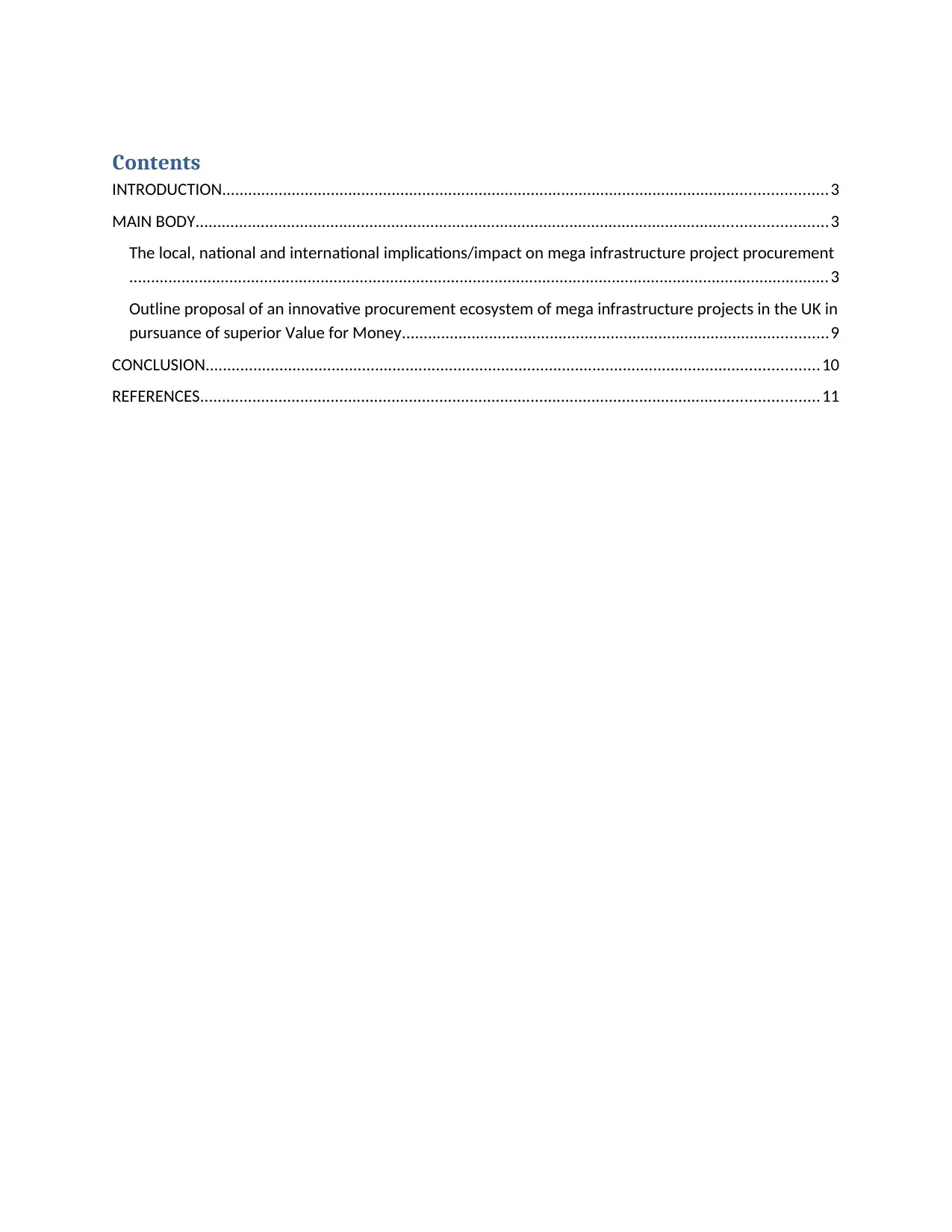
Contents
INTRODUCTION...........................................................................................................................................3
MAIN BODY.................................................................................................................................................3
The local, national and international implications/impact on mega infrastructure project procurement
.................................................................................................................................................................3
Outline proposal of an innovative procurement ecosystem of mega infrastructure projects in the UK in
pursuance of superior Value for Money..................................................................................................9
CONCLUSION.............................................................................................................................................10
REFERENCES..............................................................................................................................................11
INTRODUCTION...........................................................................................................................................3
MAIN BODY.................................................................................................................................................3
The local, national and international implications/impact on mega infrastructure project procurement
.................................................................................................................................................................3
Outline proposal of an innovative procurement ecosystem of mega infrastructure projects in the UK in
pursuance of superior Value for Money..................................................................................................9
CONCLUSION.............................................................................................................................................10
REFERENCES..............................................................................................................................................11
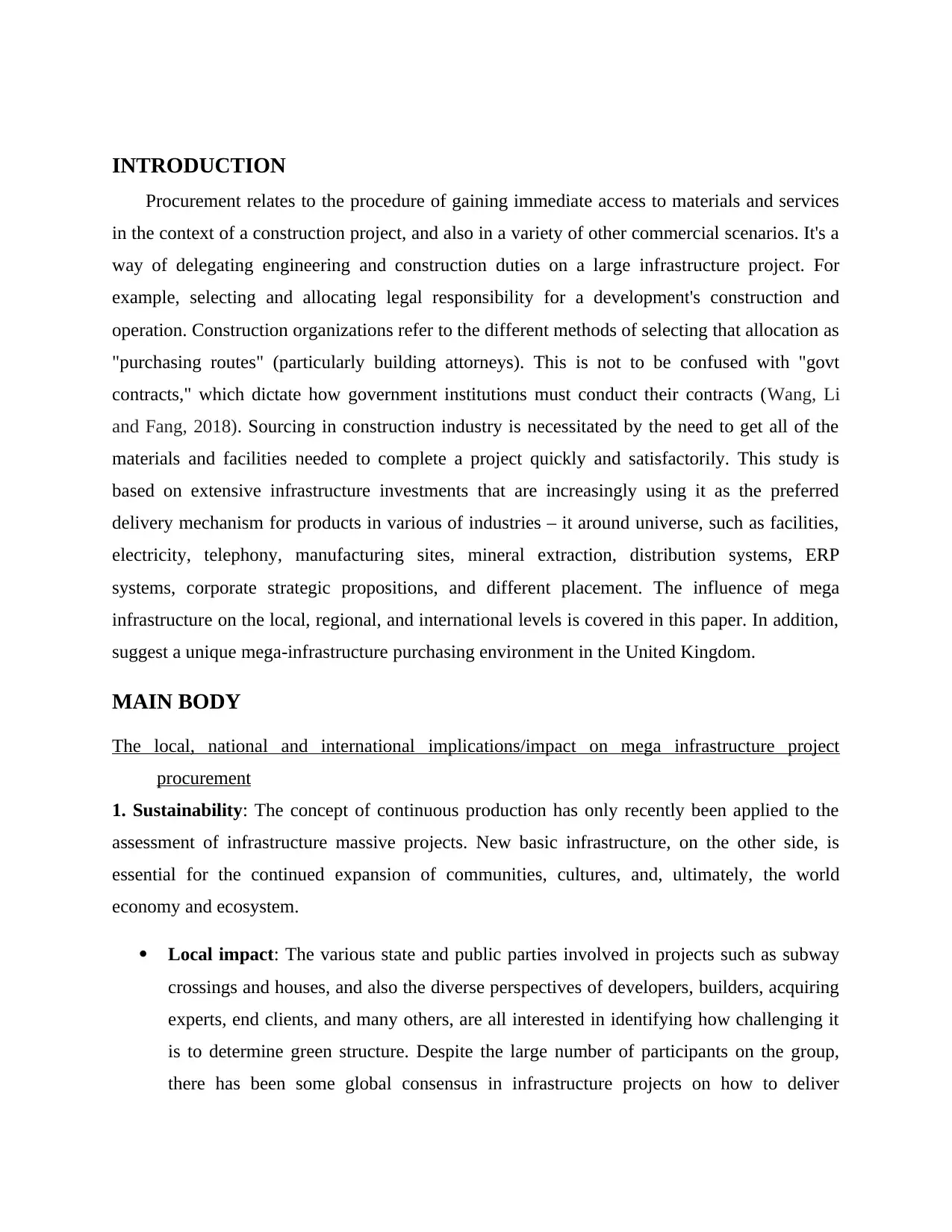
INTRODUCTION
Procurement relates to the procedure of gaining immediate access to materials and services
in the context of a construction project, and also in a variety of other commercial scenarios. It's a
way of delegating engineering and construction duties on a large infrastructure project. For
example, selecting and allocating legal responsibility for a development's construction and
operation. Construction organizations refer to the different methods of selecting that allocation as
"purchasing routes" (particularly building attorneys). This is not to be confused with "govt
contracts," which dictate how government institutions must conduct their contracts (Wang, Li
and Fang, 2018). Sourcing in construction industry is necessitated by the need to get all of the
materials and facilities needed to complete a project quickly and satisfactorily. This study is
based on extensive infrastructure investments that are increasingly using it as the preferred
delivery mechanism for products in various of industries – it around universe, such as facilities,
electricity, telephony, manufacturing sites, mineral extraction, distribution systems, ERP
systems, corporate strategic propositions, and different placement. The influence of mega
infrastructure on the local, regional, and international levels is covered in this paper. In addition,
suggest a unique mega-infrastructure purchasing environment in the United Kingdom.
MAIN BODY
The local, national and international implications/impact on mega infrastructure project
procurement
1. Sustainability: The concept of continuous production has only recently been applied to the
assessment of infrastructure massive projects. New basic infrastructure, on the other side, is
essential for the continued expansion of communities, cultures, and, ultimately, the world
economy and ecosystem.
Local impact: The various state and public parties involved in projects such as subway
crossings and houses, and also the diverse perspectives of developers, builders, acquiring
experts, end clients, and many others, are all interested in identifying how challenging it
is to determine green structure. Despite the large number of participants on the group,
there has been some global consensus in infrastructure projects on how to deliver
Procurement relates to the procedure of gaining immediate access to materials and services
in the context of a construction project, and also in a variety of other commercial scenarios. It's a
way of delegating engineering and construction duties on a large infrastructure project. For
example, selecting and allocating legal responsibility for a development's construction and
operation. Construction organizations refer to the different methods of selecting that allocation as
"purchasing routes" (particularly building attorneys). This is not to be confused with "govt
contracts," which dictate how government institutions must conduct their contracts (Wang, Li
and Fang, 2018). Sourcing in construction industry is necessitated by the need to get all of the
materials and facilities needed to complete a project quickly and satisfactorily. This study is
based on extensive infrastructure investments that are increasingly using it as the preferred
delivery mechanism for products in various of industries – it around universe, such as facilities,
electricity, telephony, manufacturing sites, mineral extraction, distribution systems, ERP
systems, corporate strategic propositions, and different placement. The influence of mega
infrastructure on the local, regional, and international levels is covered in this paper. In addition,
suggest a unique mega-infrastructure purchasing environment in the United Kingdom.
MAIN BODY
The local, national and international implications/impact on mega infrastructure project
procurement
1. Sustainability: The concept of continuous production has only recently been applied to the
assessment of infrastructure massive projects. New basic infrastructure, on the other side, is
essential for the continued expansion of communities, cultures, and, ultimately, the world
economy and ecosystem.
Local impact: The various state and public parties involved in projects such as subway
crossings and houses, and also the diverse perspectives of developers, builders, acquiring
experts, end clients, and many others, are all interested in identifying how challenging it
is to determine green structure. Despite the large number of participants on the group,
there has been some global consensus in infrastructure projects on how to deliver
Secure Best Marks with AI Grader
Need help grading? Try our AI Grader for instant feedback on your assignments.

sustainability, and purchasing has become a significant cultural and technological
revolution through which more sustainable green practices are adopted (Sparkling,
Mollaoglu and Kirca, 2017).
National effect: Long-term actions help to make a big impact on society. As people
become more environmentally aware, their carbon pollution and the amount of toxins
released into waterways will decrease, making waterways cleaner. Whenever we focus on
sustainable, we benefit the whole world, which benefits from cleaner, healthier habitats.
International effect: The project was largely supported by local resources, such as
mortgages, properties capture financing, and toll revenue. There was very little room for
trade standards or directives to incorporate innovative solutions into the architecture,
resulting in a lack of international money. A number of financial inconsistencies in the
development of a project were identified by the CAG audit, including the lack of a
written proposed study or a profitability study for the optimal facility site.
revolution through which more sustainable green practices are adopted (Sparkling,
Mollaoglu and Kirca, 2017).
National effect: Long-term actions help to make a big impact on society. As people
become more environmentally aware, their carbon pollution and the amount of toxins
released into waterways will decrease, making waterways cleaner. Whenever we focus on
sustainable, we benefit the whole world, which benefits from cleaner, healthier habitats.
International effect: The project was largely supported by local resources, such as
mortgages, properties capture financing, and toll revenue. There was very little room for
trade standards or directives to incorporate innovative solutions into the architecture,
resulting in a lack of international money. A number of financial inconsistencies in the
development of a project were identified by the CAG audit, including the lack of a
written proposed study or a profitability study for the optimal facility site.
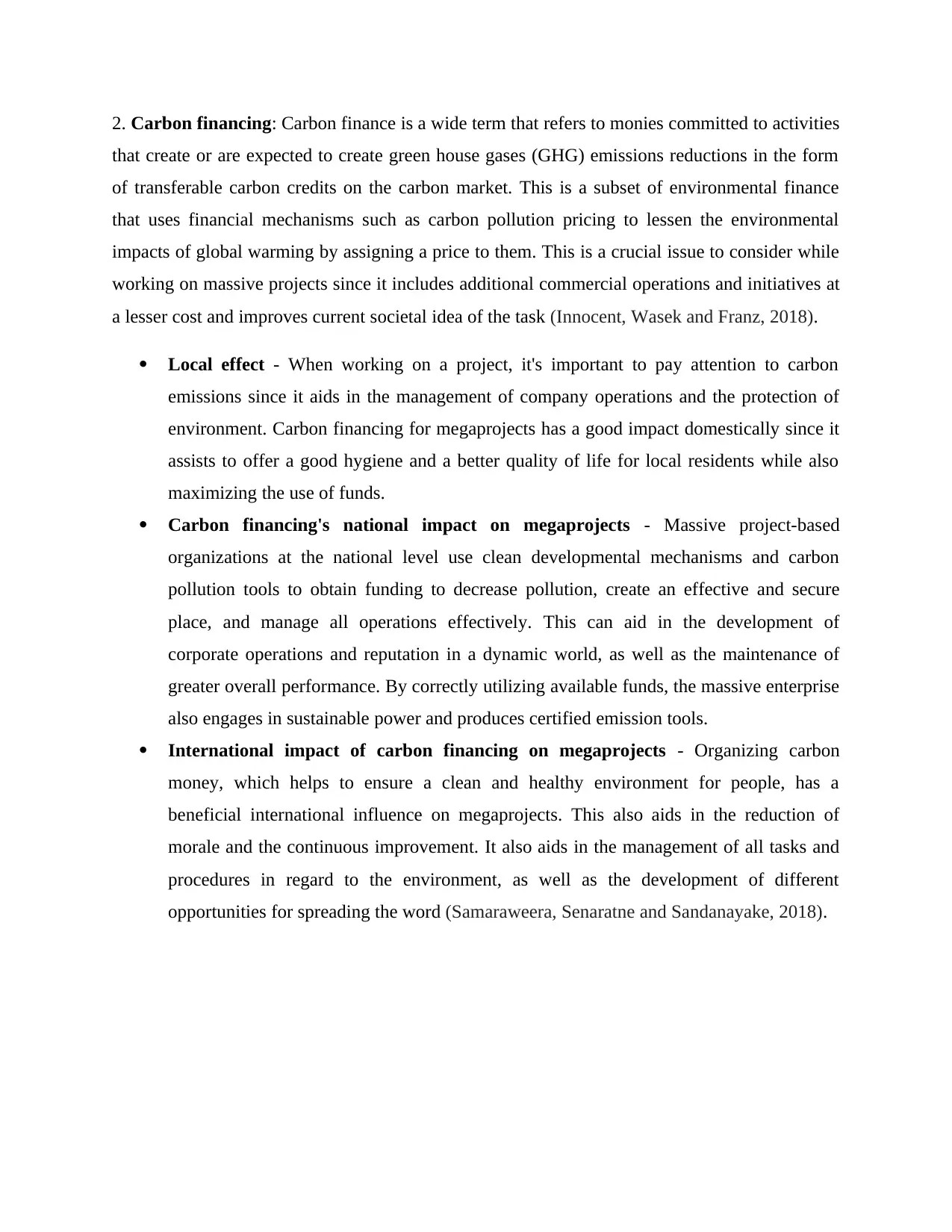
2. Carbon financing: Carbon finance is a wide term that refers to monies committed to activities
that create or are expected to create green house gases (GHG) emissions reductions in the form
of transferable carbon credits on the carbon market. This is a subset of environmental finance
that uses financial mechanisms such as carbon pollution pricing to lessen the environmental
impacts of global warming by assigning a price to them. This is a crucial issue to consider while
working on massive projects since it includes additional commercial operations and initiatives at
a lesser cost and improves current societal idea of the task (Innocent, Wasek and Franz, 2018).
Local effect - When working on a project, it's important to pay attention to carbon
emissions since it aids in the management of company operations and the protection of
environment. Carbon financing for megaprojects has a good impact domestically since it
assists to offer a good hygiene and a better quality of life for local residents while also
maximizing the use of funds.
Carbon financing's national impact on megaprojects - Massive project-based
organizations at the national level use clean developmental mechanisms and carbon
pollution tools to obtain funding to decrease pollution, create an effective and secure
place, and manage all operations effectively. This can aid in the development of
corporate operations and reputation in a dynamic world, as well as the maintenance of
greater overall performance. By correctly utilizing available funds, the massive enterprise
also engages in sustainable power and produces certified emission tools.
International impact of carbon financing on megaprojects - Organizing carbon
money, which helps to ensure a clean and healthy environment for people, has a
beneficial international influence on megaprojects. This also aids in the reduction of
morale and the continuous improvement. It also aids in the management of all tasks and
procedures in regard to the environment, as well as the development of different
opportunities for spreading the word (Samaraweera, Senaratne and Sandanayake, 2018).
that create or are expected to create green house gases (GHG) emissions reductions in the form
of transferable carbon credits on the carbon market. This is a subset of environmental finance
that uses financial mechanisms such as carbon pollution pricing to lessen the environmental
impacts of global warming by assigning a price to them. This is a crucial issue to consider while
working on massive projects since it includes additional commercial operations and initiatives at
a lesser cost and improves current societal idea of the task (Innocent, Wasek and Franz, 2018).
Local effect - When working on a project, it's important to pay attention to carbon
emissions since it aids in the management of company operations and the protection of
environment. Carbon financing for megaprojects has a good impact domestically since it
assists to offer a good hygiene and a better quality of life for local residents while also
maximizing the use of funds.
Carbon financing's national impact on megaprojects - Massive project-based
organizations at the national level use clean developmental mechanisms and carbon
pollution tools to obtain funding to decrease pollution, create an effective and secure
place, and manage all operations effectively. This can aid in the development of
corporate operations and reputation in a dynamic world, as well as the maintenance of
greater overall performance. By correctly utilizing available funds, the massive enterprise
also engages in sustainable power and produces certified emission tools.
International impact of carbon financing on megaprojects - Organizing carbon
money, which helps to ensure a clean and healthy environment for people, has a
beneficial international influence on megaprojects. This also aids in the reduction of
morale and the continuous improvement. It also aids in the management of all tasks and
procedures in regard to the environment, as well as the development of different
opportunities for spreading the word (Samaraweera, Senaratne and Sandanayake, 2018).
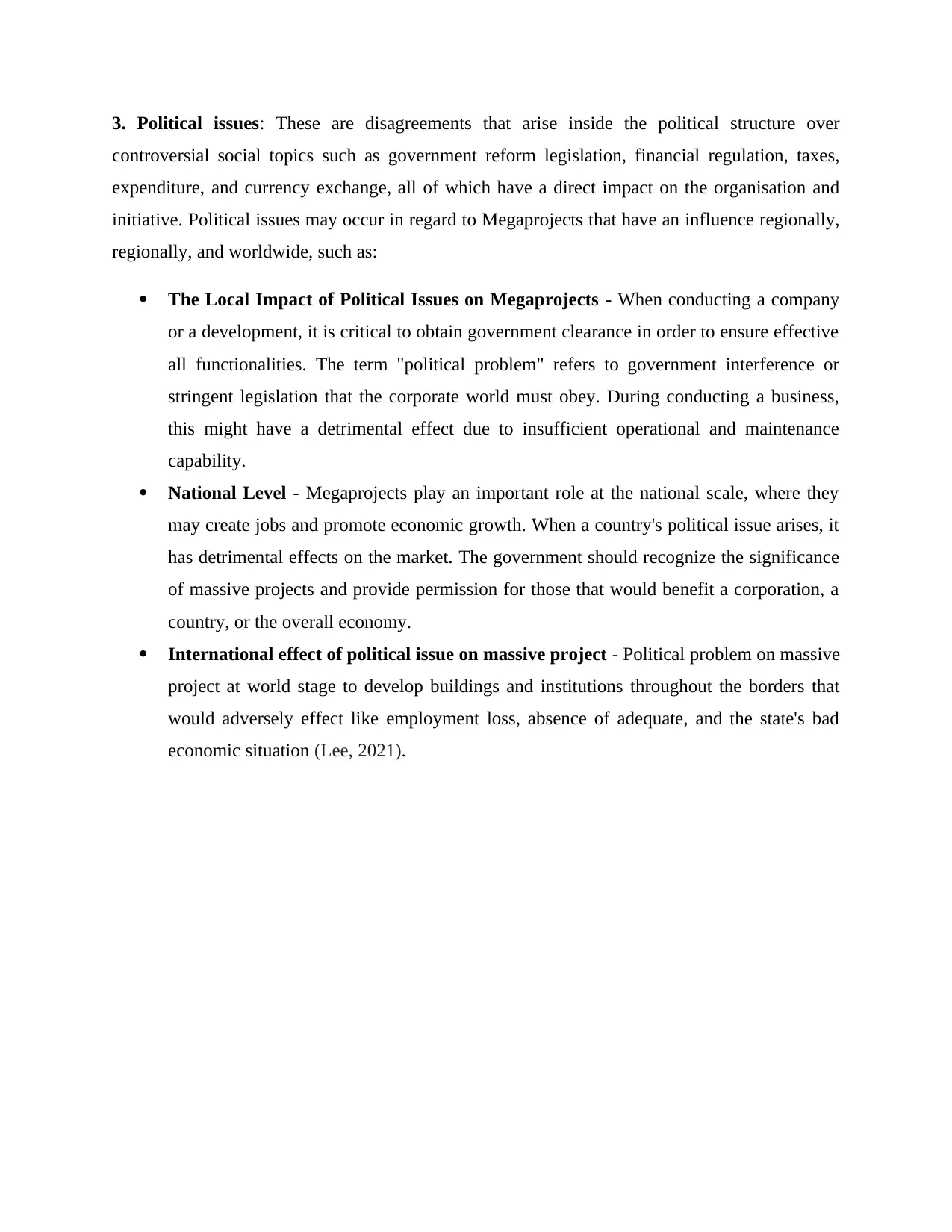
3. Political issues: These are disagreements that arise inside the political structure over
controversial social topics such as government reform legislation, financial regulation, taxes,
expenditure, and currency exchange, all of which have a direct impact on the organisation and
initiative. Political issues may occur in regard to Megaprojects that have an influence regionally,
regionally, and worldwide, such as:
The Local Impact of Political Issues on Megaprojects - When conducting a company
or a development, it is critical to obtain government clearance in order to ensure effective
all functionalities. The term "political problem" refers to government interference or
stringent legislation that the corporate world must obey. During conducting a business,
this might have a detrimental effect due to insufficient operational and maintenance
capability.
National Level - Megaprojects play an important role at the national scale, where they
may create jobs and promote economic growth. When a country's political issue arises, it
has detrimental effects on the market. The government should recognize the significance
of massive projects and provide permission for those that would benefit a corporation, a
country, or the overall economy.
International effect of political issue on massive project - Political problem on massive
project at world stage to develop buildings and institutions throughout the borders that
would adversely effect like employment loss, absence of adequate, and the state's bad
economic situation (Lee, 2021).
controversial social topics such as government reform legislation, financial regulation, taxes,
expenditure, and currency exchange, all of which have a direct impact on the organisation and
initiative. Political issues may occur in regard to Megaprojects that have an influence regionally,
regionally, and worldwide, such as:
The Local Impact of Political Issues on Megaprojects - When conducting a company
or a development, it is critical to obtain government clearance in order to ensure effective
all functionalities. The term "political problem" refers to government interference or
stringent legislation that the corporate world must obey. During conducting a business,
this might have a detrimental effect due to insufficient operational and maintenance
capability.
National Level - Megaprojects play an important role at the national scale, where they
may create jobs and promote economic growth. When a country's political issue arises, it
has detrimental effects on the market. The government should recognize the significance
of massive projects and provide permission for those that would benefit a corporation, a
country, or the overall economy.
International effect of political issue on massive project - Political problem on massive
project at world stage to develop buildings and institutions throughout the borders that
would adversely effect like employment loss, absence of adequate, and the state's bad
economic situation (Lee, 2021).
Paraphrase This Document
Need a fresh take? Get an instant paraphrase of this document with our AI Paraphraser
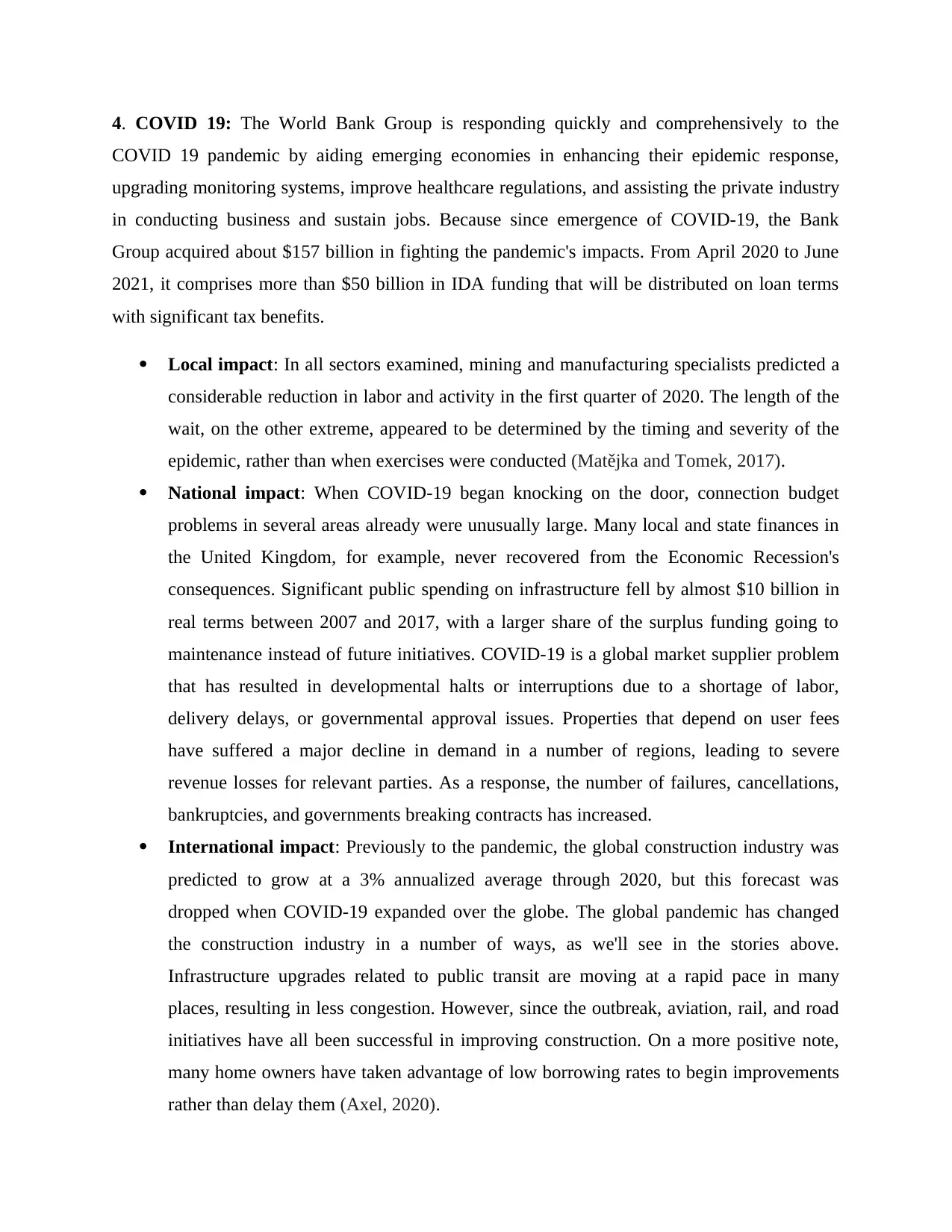
4. COVID 19: The World Bank Group is responding quickly and comprehensively to the
COVID 19 pandemic by aiding emerging economies in enhancing their epidemic response,
upgrading monitoring systems, improve healthcare regulations, and assisting the private industry
in conducting business and sustain jobs. Because since emergence of COVID-19, the Bank
Group acquired about $157 billion in fighting the pandemic's impacts. From April 2020 to June
2021, it comprises more than $50 billion in IDA funding that will be distributed on loan terms
with significant tax benefits.
Local impact: In all sectors examined, mining and manufacturing specialists predicted a
considerable reduction in labor and activity in the first quarter of 2020. The length of the
wait, on the other extreme, appeared to be determined by the timing and severity of the
epidemic, rather than when exercises were conducted (Matějka and Tomek, 2017).
National impact: When COVID-19 began knocking on the door, connection budget
problems in several areas already were unusually large. Many local and state finances in
the United Kingdom, for example, never recovered from the Economic Recession's
consequences. Significant public spending on infrastructure fell by almost $10 billion in
real terms between 2007 and 2017, with a larger share of the surplus funding going to
maintenance instead of future initiatives. COVID-19 is a global market supplier problem
that has resulted in developmental halts or interruptions due to a shortage of labor,
delivery delays, or governmental approval issues. Properties that depend on user fees
have suffered a major decline in demand in a number of regions, leading to severe
revenue losses for relevant parties. As a response, the number of failures, cancellations,
bankruptcies, and governments breaking contracts has increased.
International impact: Previously to the pandemic, the global construction industry was
predicted to grow at a 3% annualized average through 2020, but this forecast was
dropped when COVID-19 expanded over the globe. The global pandemic has changed
the construction industry in a number of ways, as we'll see in the stories above.
Infrastructure upgrades related to public transit are moving at a rapid pace in many
places, resulting in less congestion. However, since the outbreak, aviation, rail, and road
initiatives have all been successful in improving construction. On a more positive note,
many home owners have taken advantage of low borrowing rates to begin improvements
rather than delay them (Axel, 2020).
COVID 19 pandemic by aiding emerging economies in enhancing their epidemic response,
upgrading monitoring systems, improve healthcare regulations, and assisting the private industry
in conducting business and sustain jobs. Because since emergence of COVID-19, the Bank
Group acquired about $157 billion in fighting the pandemic's impacts. From April 2020 to June
2021, it comprises more than $50 billion in IDA funding that will be distributed on loan terms
with significant tax benefits.
Local impact: In all sectors examined, mining and manufacturing specialists predicted a
considerable reduction in labor and activity in the first quarter of 2020. The length of the
wait, on the other extreme, appeared to be determined by the timing and severity of the
epidemic, rather than when exercises were conducted (Matějka and Tomek, 2017).
National impact: When COVID-19 began knocking on the door, connection budget
problems in several areas already were unusually large. Many local and state finances in
the United Kingdom, for example, never recovered from the Economic Recession's
consequences. Significant public spending on infrastructure fell by almost $10 billion in
real terms between 2007 and 2017, with a larger share of the surplus funding going to
maintenance instead of future initiatives. COVID-19 is a global market supplier problem
that has resulted in developmental halts or interruptions due to a shortage of labor,
delivery delays, or governmental approval issues. Properties that depend on user fees
have suffered a major decline in demand in a number of regions, leading to severe
revenue losses for relevant parties. As a response, the number of failures, cancellations,
bankruptcies, and governments breaking contracts has increased.
International impact: Previously to the pandemic, the global construction industry was
predicted to grow at a 3% annualized average through 2020, but this forecast was
dropped when COVID-19 expanded over the globe. The global pandemic has changed
the construction industry in a number of ways, as we'll see in the stories above.
Infrastructure upgrades related to public transit are moving at a rapid pace in many
places, resulting in less congestion. However, since the outbreak, aviation, rail, and road
initiatives have all been successful in improving construction. On a more positive note,
many home owners have taken advantage of low borrowing rates to begin improvements
rather than delay them (Axel, 2020).
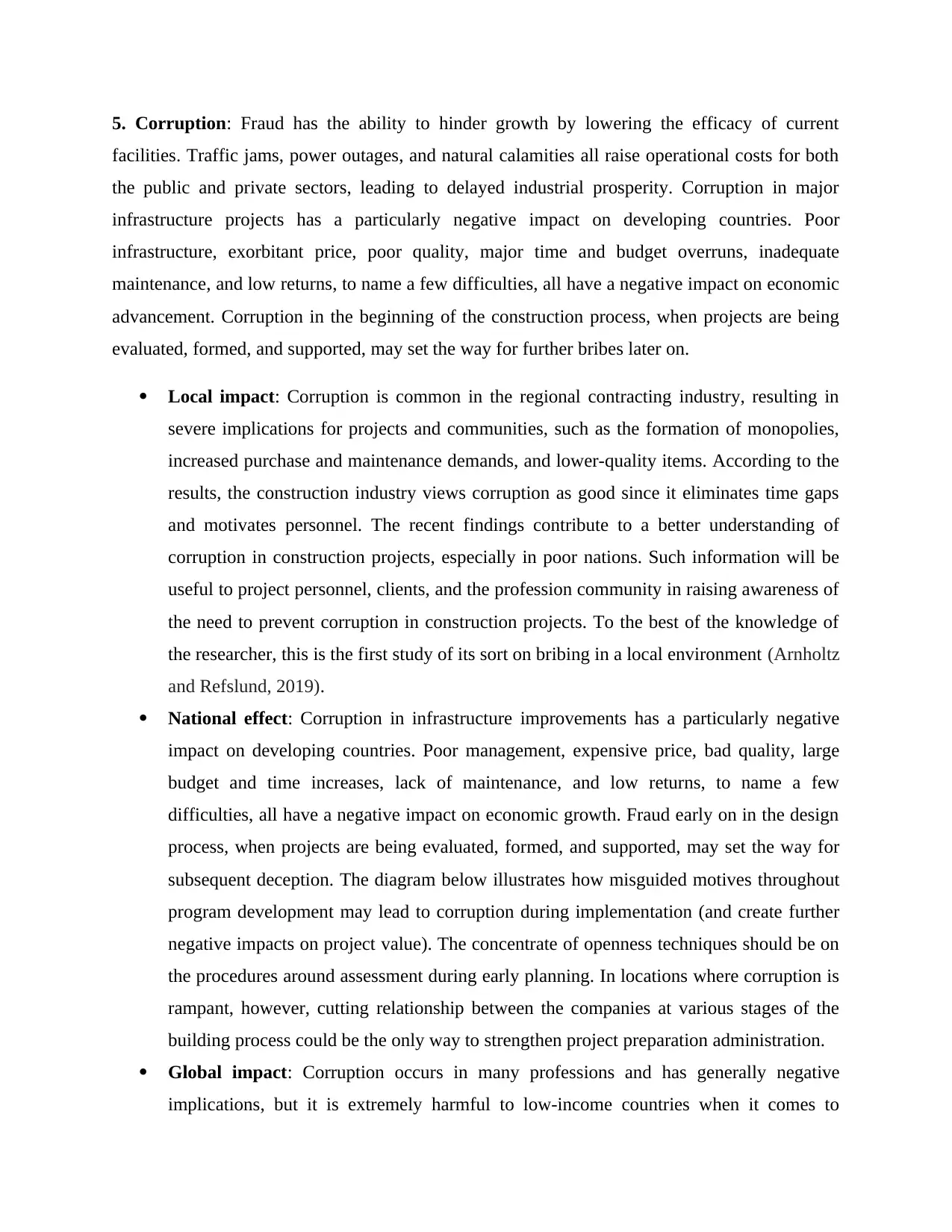
5. Corruption: Fraud has the ability to hinder growth by lowering the efficacy of current
facilities. Traffic jams, power outages, and natural calamities all raise operational costs for both
the public and private sectors, leading to delayed industrial prosperity. Corruption in major
infrastructure projects has a particularly negative impact on developing countries. Poor
infrastructure, exorbitant price, poor quality, major time and budget overruns, inadequate
maintenance, and low returns, to name a few difficulties, all have a negative impact on economic
advancement. Corruption in the beginning of the construction process, when projects are being
evaluated, formed, and supported, may set the way for further bribes later on.
Local impact: Corruption is common in the regional contracting industry, resulting in
severe implications for projects and communities, such as the formation of monopolies,
increased purchase and maintenance demands, and lower-quality items. According to the
results, the construction industry views corruption as good since it eliminates time gaps
and motivates personnel. The recent findings contribute to a better understanding of
corruption in construction projects, especially in poor nations. Such information will be
useful to project personnel, clients, and the profession community in raising awareness of
the need to prevent corruption in construction projects. To the best of the knowledge of
the researcher, this is the first study of its sort on bribing in a local environment (Arnholtz
and Refslund, 2019).
National effect: Corruption in infrastructure improvements has a particularly negative
impact on developing countries. Poor management, expensive price, bad quality, large
budget and time increases, lack of maintenance, and low returns, to name a few
difficulties, all have a negative impact on economic growth. Fraud early on in the design
process, when projects are being evaluated, formed, and supported, may set the way for
subsequent deception. The diagram below illustrates how misguided motives throughout
program development may lead to corruption during implementation (and create further
negative impacts on project value). The concentrate of openness techniques should be on
the procedures around assessment during early planning. In locations where corruption is
rampant, however, cutting relationship between the companies at various stages of the
building process could be the only way to strengthen project preparation administration.
Global impact: Corruption occurs in many professions and has generally negative
implications, but it is extremely harmful to low-income countries when it comes to
facilities. Traffic jams, power outages, and natural calamities all raise operational costs for both
the public and private sectors, leading to delayed industrial prosperity. Corruption in major
infrastructure projects has a particularly negative impact on developing countries. Poor
infrastructure, exorbitant price, poor quality, major time and budget overruns, inadequate
maintenance, and low returns, to name a few difficulties, all have a negative impact on economic
advancement. Corruption in the beginning of the construction process, when projects are being
evaluated, formed, and supported, may set the way for further bribes later on.
Local impact: Corruption is common in the regional contracting industry, resulting in
severe implications for projects and communities, such as the formation of monopolies,
increased purchase and maintenance demands, and lower-quality items. According to the
results, the construction industry views corruption as good since it eliminates time gaps
and motivates personnel. The recent findings contribute to a better understanding of
corruption in construction projects, especially in poor nations. Such information will be
useful to project personnel, clients, and the profession community in raising awareness of
the need to prevent corruption in construction projects. To the best of the knowledge of
the researcher, this is the first study of its sort on bribing in a local environment (Arnholtz
and Refslund, 2019).
National effect: Corruption in infrastructure improvements has a particularly negative
impact on developing countries. Poor management, expensive price, bad quality, large
budget and time increases, lack of maintenance, and low returns, to name a few
difficulties, all have a negative impact on economic growth. Fraud early on in the design
process, when projects are being evaluated, formed, and supported, may set the way for
subsequent deception. The diagram below illustrates how misguided motives throughout
program development may lead to corruption during implementation (and create further
negative impacts on project value). The concentrate of openness techniques should be on
the procedures around assessment during early planning. In locations where corruption is
rampant, however, cutting relationship between the companies at various stages of the
building process could be the only way to strengthen project preparation administration.
Global impact: Corruption occurs in many professions and has generally negative
implications, but it is extremely harmful to low-income countries when it comes to
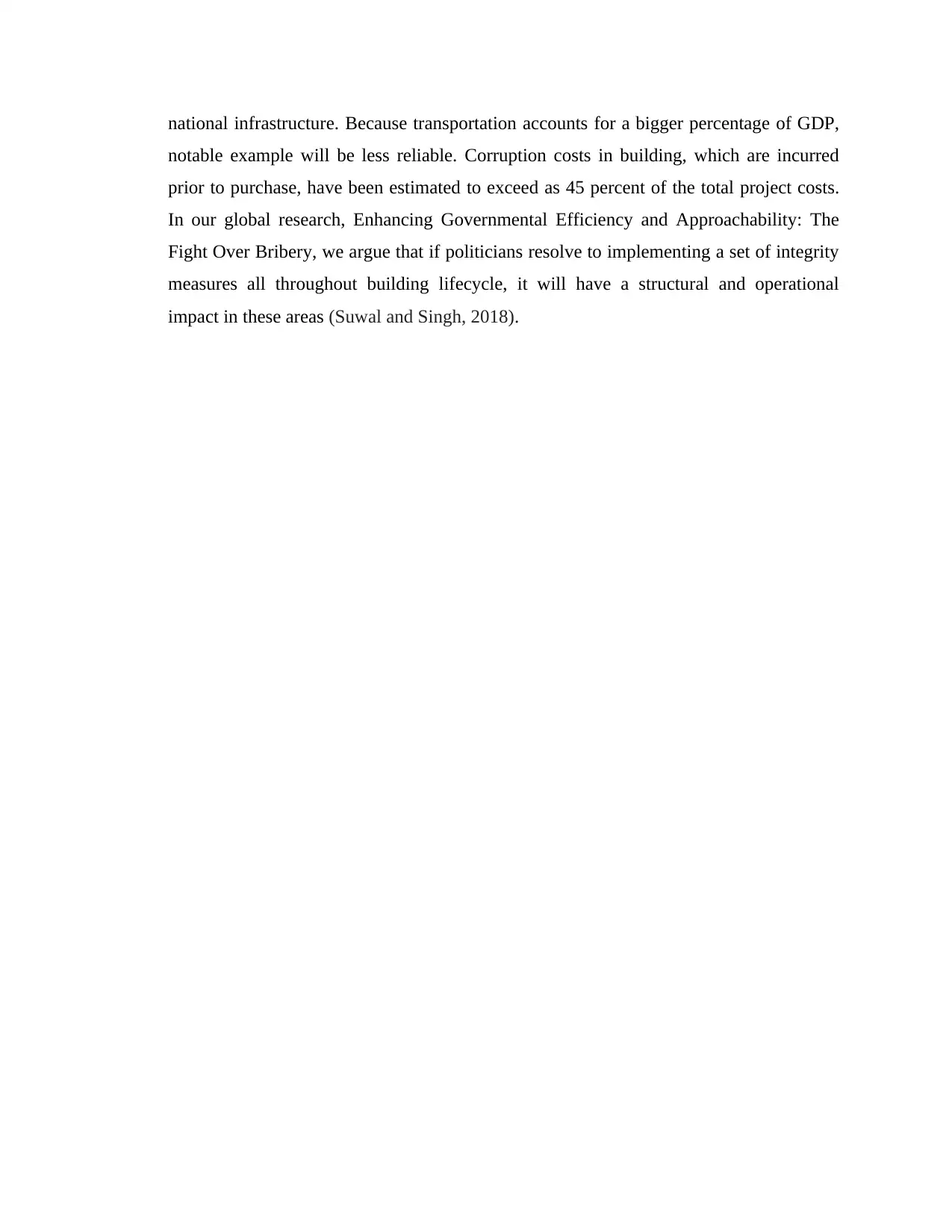
national infrastructure. Because transportation accounts for a bigger percentage of GDP,
notable example will be less reliable. Corruption costs in building, which are incurred
prior to purchase, have been estimated to exceed as 45 percent of the total project costs.
In our global research, Enhancing Governmental Efficiency and Approachability: The
Fight Over Bribery, we argue that if politicians resolve to implementing a set of integrity
measures all throughout building lifecycle, it will have a structural and operational
impact in these areas (Suwal and Singh, 2018).
notable example will be less reliable. Corruption costs in building, which are incurred
prior to purchase, have been estimated to exceed as 45 percent of the total project costs.
In our global research, Enhancing Governmental Efficiency and Approachability: The
Fight Over Bribery, we argue that if politicians resolve to implementing a set of integrity
measures all throughout building lifecycle, it will have a structural and operational
impact in these areas (Suwal and Singh, 2018).
Secure Best Marks with AI Grader
Need help grading? Try our AI Grader for instant feedback on your assignments.
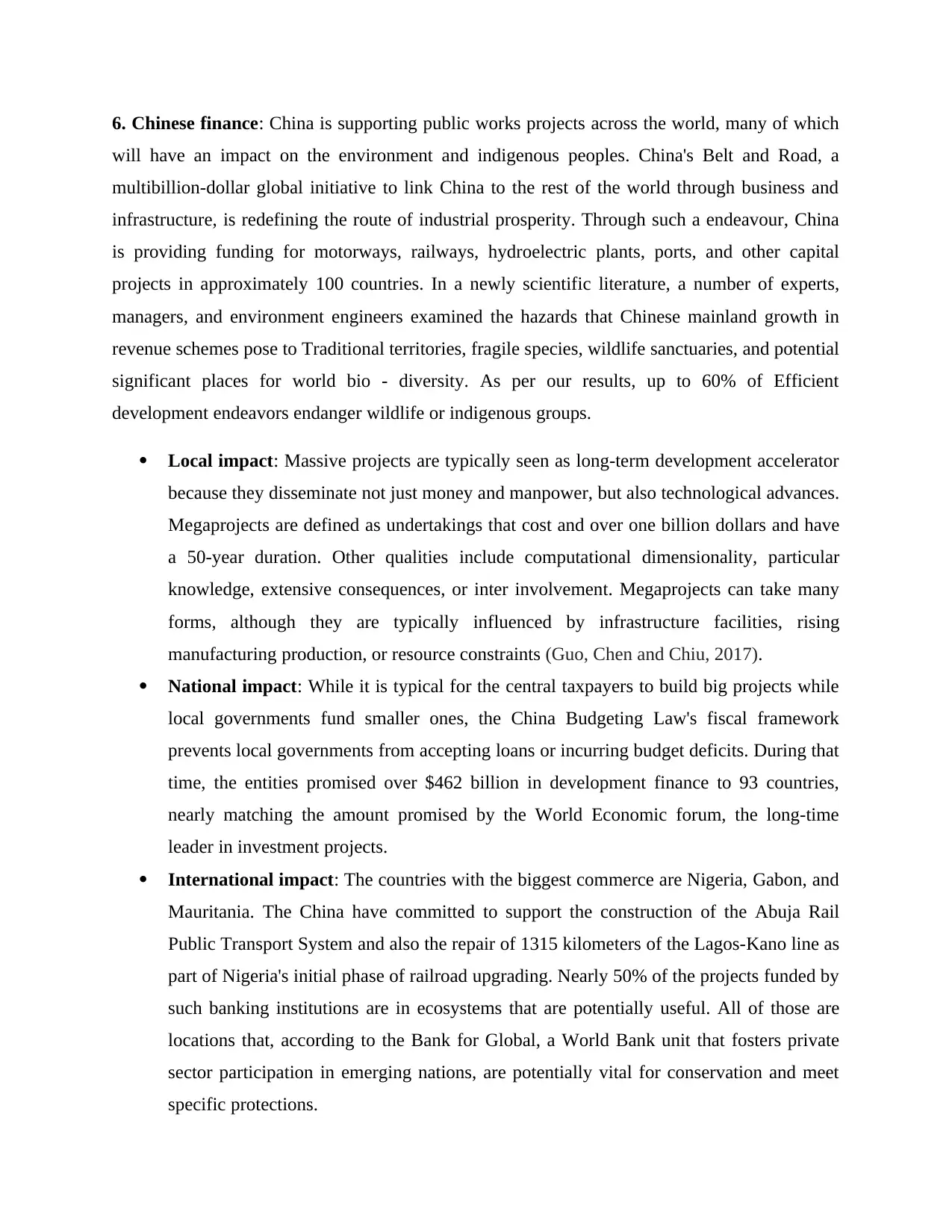
6. Chinese finance: China is supporting public works projects across the world, many of which
will have an impact on the environment and indigenous peoples. China's Belt and Road, a
multibillion-dollar global initiative to link China to the rest of the world through business and
infrastructure, is redefining the route of industrial prosperity. Through such a endeavour, China
is providing funding for motorways, railways, hydroelectric plants, ports, and other capital
projects in approximately 100 countries. In a newly scientific literature, a number of experts,
managers, and environment engineers examined the hazards that Chinese mainland growth in
revenue schemes pose to Traditional territories, fragile species, wildlife sanctuaries, and potential
significant places for world bio - diversity. As per our results, up to 60% of Efficient
development endeavors endanger wildlife or indigenous groups.
Local impact: Massive projects are typically seen as long-term development accelerator
because they disseminate not just money and manpower, but also technological advances.
Megaprojects are defined as undertakings that cost and over one billion dollars and have
a 50-year duration. Other qualities include computational dimensionality, particular
knowledge, extensive consequences, or inter involvement. Megaprojects can take many
forms, although they are typically influenced by infrastructure facilities, rising
manufacturing production, or resource constraints (Guo, Chen and Chiu, 2017).
National impact: While it is typical for the central taxpayers to build big projects while
local governments fund smaller ones, the China Budgeting Law's fiscal framework
prevents local governments from accepting loans or incurring budget deficits. During that
time, the entities promised over $462 billion in development finance to 93 countries,
nearly matching the amount promised by the World Economic forum, the long-time
leader in investment projects.
International impact: The countries with the biggest commerce are Nigeria, Gabon, and
Mauritania. The China have committed to support the construction of the Abuja Rail
Public Transport System and also the repair of 1315 kilometers of the Lagos-Kano line as
part of Nigeria's initial phase of railroad upgrading. Nearly 50% of the projects funded by
such banking institutions are in ecosystems that are potentially useful. All of those are
locations that, according to the Bank for Global, a World Bank unit that fosters private
sector participation in emerging nations, are potentially vital for conservation and meet
specific protections.
will have an impact on the environment and indigenous peoples. China's Belt and Road, a
multibillion-dollar global initiative to link China to the rest of the world through business and
infrastructure, is redefining the route of industrial prosperity. Through such a endeavour, China
is providing funding for motorways, railways, hydroelectric plants, ports, and other capital
projects in approximately 100 countries. In a newly scientific literature, a number of experts,
managers, and environment engineers examined the hazards that Chinese mainland growth in
revenue schemes pose to Traditional territories, fragile species, wildlife sanctuaries, and potential
significant places for world bio - diversity. As per our results, up to 60% of Efficient
development endeavors endanger wildlife or indigenous groups.
Local impact: Massive projects are typically seen as long-term development accelerator
because they disseminate not just money and manpower, but also technological advances.
Megaprojects are defined as undertakings that cost and over one billion dollars and have
a 50-year duration. Other qualities include computational dimensionality, particular
knowledge, extensive consequences, or inter involvement. Megaprojects can take many
forms, although they are typically influenced by infrastructure facilities, rising
manufacturing production, or resource constraints (Guo, Chen and Chiu, 2017).
National impact: While it is typical for the central taxpayers to build big projects while
local governments fund smaller ones, the China Budgeting Law's fiscal framework
prevents local governments from accepting loans or incurring budget deficits. During that
time, the entities promised over $462 billion in development finance to 93 countries,
nearly matching the amount promised by the World Economic forum, the long-time
leader in investment projects.
International impact: The countries with the biggest commerce are Nigeria, Gabon, and
Mauritania. The China have committed to support the construction of the Abuja Rail
Public Transport System and also the repair of 1315 kilometers of the Lagos-Kano line as
part of Nigeria's initial phase of railroad upgrading. Nearly 50% of the projects funded by
such banking institutions are in ecosystems that are potentially useful. All of those are
locations that, according to the Bank for Global, a World Bank unit that fosters private
sector participation in emerging nations, are potentially vital for conservation and meet
specific protections.
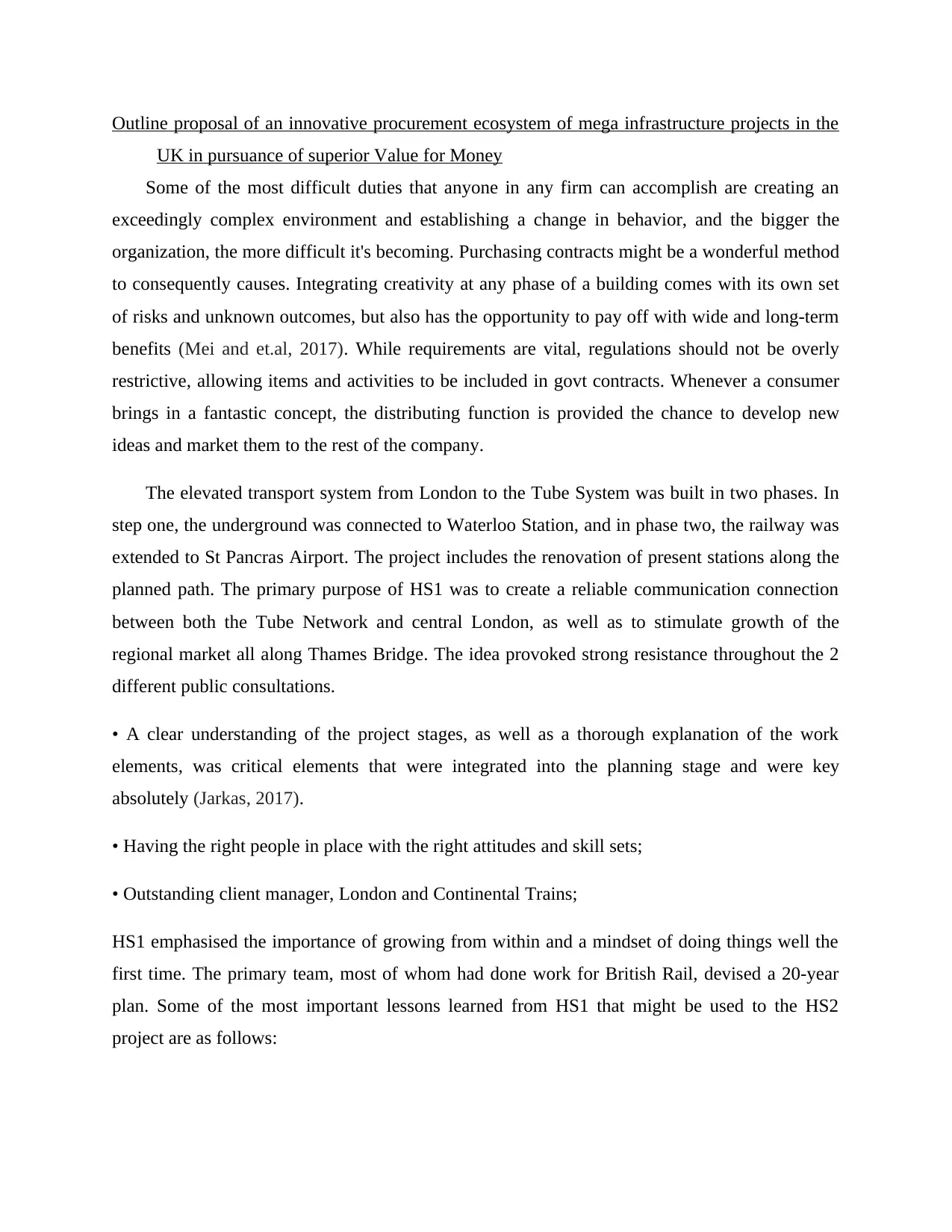
Outline proposal of an innovative procurement ecosystem of mega infrastructure projects in the
UK in pursuance of superior Value for Money
Some of the most difficult duties that anyone in any firm can accomplish are creating an
exceedingly complex environment and establishing a change in behavior, and the bigger the
organization, the more difficult it's becoming. Purchasing contracts might be a wonderful method
to consequently causes. Integrating creativity at any phase of a building comes with its own set
of risks and unknown outcomes, but also has the opportunity to pay off with wide and long-term
benefits (Mei and et.al, 2017). While requirements are vital, regulations should not be overly
restrictive, allowing items and activities to be included in govt contracts. Whenever a consumer
brings in a fantastic concept, the distributing function is provided the chance to develop new
ideas and market them to the rest of the company.
The elevated transport system from London to the Tube System was built in two phases. In
step one, the underground was connected to Waterloo Station, and in phase two, the railway was
extended to St Pancras Airport. The project includes the renovation of present stations along the
planned path. The primary purpose of HS1 was to create a reliable communication connection
between both the Tube Network and central London, as well as to stimulate growth of the
regional market all along Thames Bridge. The idea provoked strong resistance throughout the 2
different public consultations.
• A clear understanding of the project stages, as well as a thorough explanation of the work
elements, was critical elements that were integrated into the planning stage and were key
absolutely (Jarkas, 2017).
• Having the right people in place with the right attitudes and skill sets;
• Outstanding client manager, London and Continental Trains;
HS1 emphasised the importance of growing from within and a mindset of doing things well the
first time. The primary team, most of whom had done work for British Rail, devised a 20-year
plan. Some of the most important lessons learned from HS1 that might be used to the HS2
project are as follows:
UK in pursuance of superior Value for Money
Some of the most difficult duties that anyone in any firm can accomplish are creating an
exceedingly complex environment and establishing a change in behavior, and the bigger the
organization, the more difficult it's becoming. Purchasing contracts might be a wonderful method
to consequently causes. Integrating creativity at any phase of a building comes with its own set
of risks and unknown outcomes, but also has the opportunity to pay off with wide and long-term
benefits (Mei and et.al, 2017). While requirements are vital, regulations should not be overly
restrictive, allowing items and activities to be included in govt contracts. Whenever a consumer
brings in a fantastic concept, the distributing function is provided the chance to develop new
ideas and market them to the rest of the company.
The elevated transport system from London to the Tube System was built in two phases. In
step one, the underground was connected to Waterloo Station, and in phase two, the railway was
extended to St Pancras Airport. The project includes the renovation of present stations along the
planned path. The primary purpose of HS1 was to create a reliable communication connection
between both the Tube Network and central London, as well as to stimulate growth of the
regional market all along Thames Bridge. The idea provoked strong resistance throughout the 2
different public consultations.
• A clear understanding of the project stages, as well as a thorough explanation of the work
elements, was critical elements that were integrated into the planning stage and were key
absolutely (Jarkas, 2017).
• Having the right people in place with the right attitudes and skill sets;
• Outstanding client manager, London and Continental Trains;
HS1 emphasised the importance of growing from within and a mindset of doing things well the
first time. The primary team, most of whom had done work for British Rail, devised a 20-year
plan. Some of the most important lessons learned from HS1 that might be used to the HS2
project are as follows:
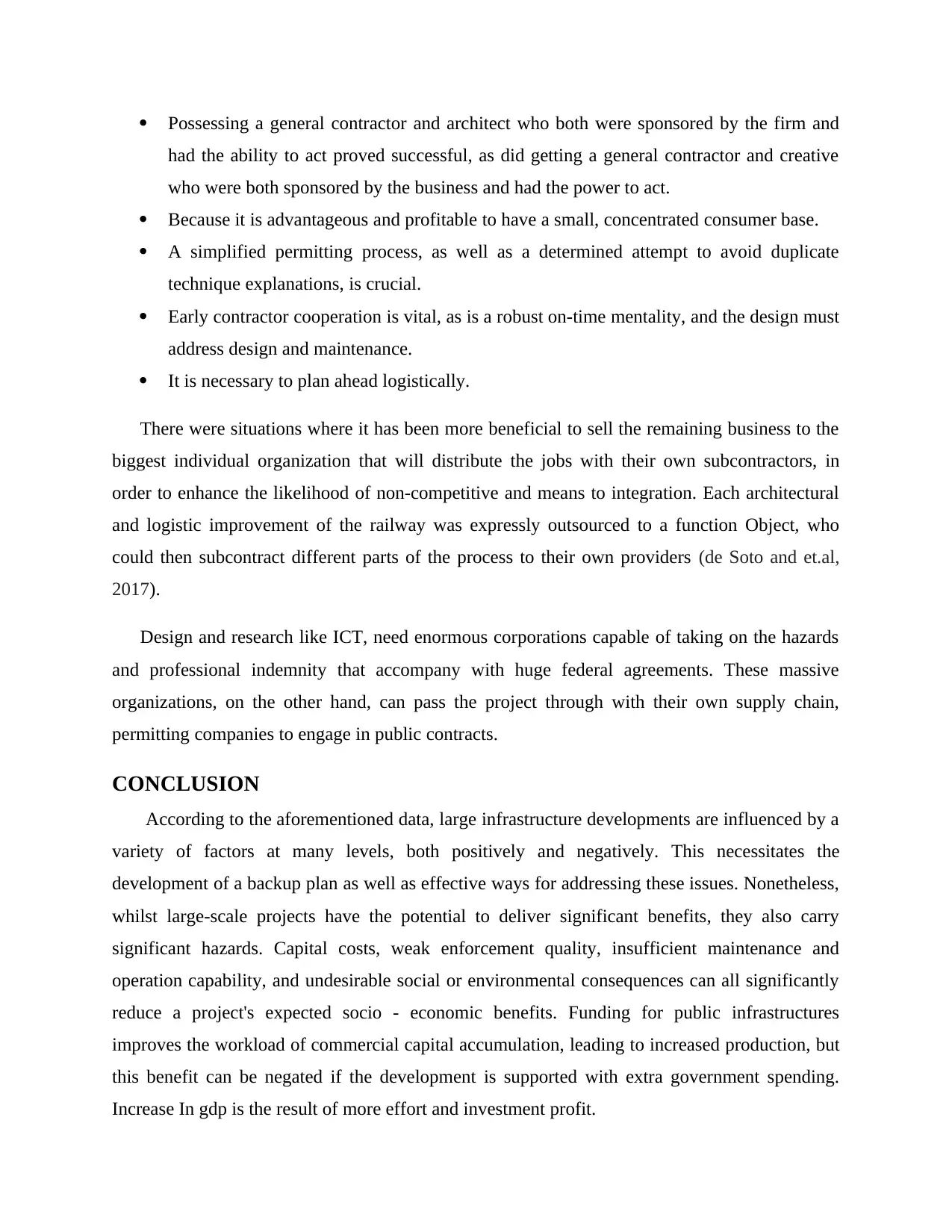
Possessing a general contractor and architect who both were sponsored by the firm and
had the ability to act proved successful, as did getting a general contractor and creative
who were both sponsored by the business and had the power to act.
Because it is advantageous and profitable to have a small, concentrated consumer base.
A simplified permitting process, as well as a determined attempt to avoid duplicate
technique explanations, is crucial.
Early contractor cooperation is vital, as is a robust on-time mentality, and the design must
address design and maintenance.
It is necessary to plan ahead logistically.
There were situations where it has been more beneficial to sell the remaining business to the
biggest individual organization that will distribute the jobs with their own subcontractors, in
order to enhance the likelihood of non-competitive and means to integration. Each architectural
and logistic improvement of the railway was expressly outsourced to a function Object, who
could then subcontract different parts of the process to their own providers (de Soto and et.al,
2017).
Design and research like ICT, need enormous corporations capable of taking on the hazards
and professional indemnity that accompany with huge federal agreements. These massive
organizations, on the other hand, can pass the project through with their own supply chain,
permitting companies to engage in public contracts.
CONCLUSION
According to the aforementioned data, large infrastructure developments are influenced by a
variety of factors at many levels, both positively and negatively. This necessitates the
development of a backup plan as well as effective ways for addressing these issues. Nonetheless,
whilst large-scale projects have the potential to deliver significant benefits, they also carry
significant hazards. Capital costs, weak enforcement quality, insufficient maintenance and
operation capability, and undesirable social or environmental consequences can all significantly
reduce a project's expected socio - economic benefits. Funding for public infrastructures
improves the workload of commercial capital accumulation, leading to increased production, but
this benefit can be negated if the development is supported with extra government spending.
Increase In gdp is the result of more effort and investment profit.
had the ability to act proved successful, as did getting a general contractor and creative
who were both sponsored by the business and had the power to act.
Because it is advantageous and profitable to have a small, concentrated consumer base.
A simplified permitting process, as well as a determined attempt to avoid duplicate
technique explanations, is crucial.
Early contractor cooperation is vital, as is a robust on-time mentality, and the design must
address design and maintenance.
It is necessary to plan ahead logistically.
There were situations where it has been more beneficial to sell the remaining business to the
biggest individual organization that will distribute the jobs with their own subcontractors, in
order to enhance the likelihood of non-competitive and means to integration. Each architectural
and logistic improvement of the railway was expressly outsourced to a function Object, who
could then subcontract different parts of the process to their own providers (de Soto and et.al,
2017).
Design and research like ICT, need enormous corporations capable of taking on the hazards
and professional indemnity that accompany with huge federal agreements. These massive
organizations, on the other hand, can pass the project through with their own supply chain,
permitting companies to engage in public contracts.
CONCLUSION
According to the aforementioned data, large infrastructure developments are influenced by a
variety of factors at many levels, both positively and negatively. This necessitates the
development of a backup plan as well as effective ways for addressing these issues. Nonetheless,
whilst large-scale projects have the potential to deliver significant benefits, they also carry
significant hazards. Capital costs, weak enforcement quality, insufficient maintenance and
operation capability, and undesirable social or environmental consequences can all significantly
reduce a project's expected socio - economic benefits. Funding for public infrastructures
improves the workload of commercial capital accumulation, leading to increased production, but
this benefit can be negated if the development is supported with extra government spending.
Increase In gdp is the result of more effort and investment profit.
Paraphrase This Document
Need a fresh take? Get an instant paraphrase of this document with our AI Paraphraser

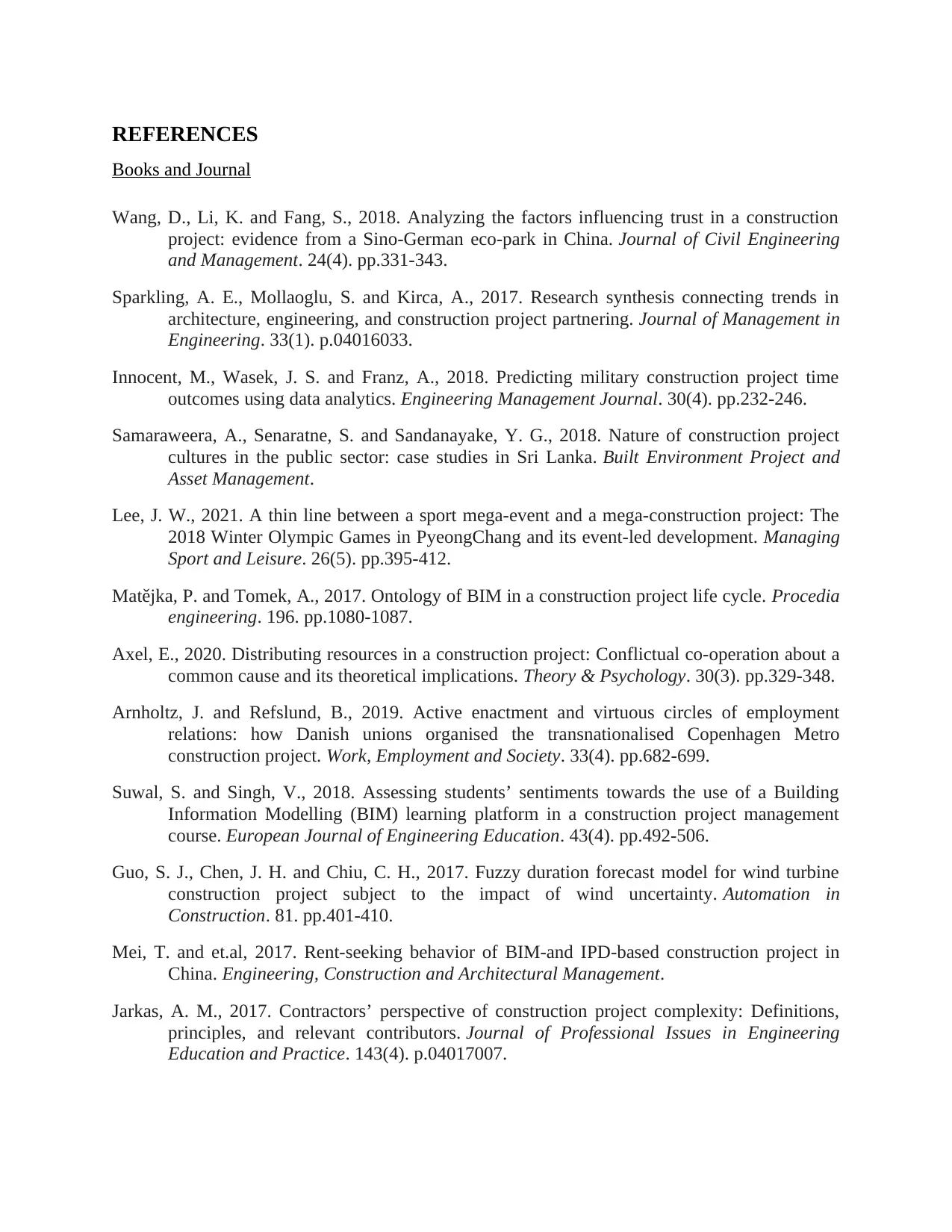
REFERENCES
Books and Journal
Wang, D., Li, K. and Fang, S., 2018. Analyzing the factors influencing trust in a construction
project: evidence from a Sino-German eco-park in China. Journal of Civil Engineering
and Management. 24(4). pp.331-343.
Sparkling, A. E., Mollaoglu, S. and Kirca, A., 2017. Research synthesis connecting trends in
architecture, engineering, and construction project partnering. Journal of Management in
Engineering. 33(1). p.04016033.
Innocent, M., Wasek, J. S. and Franz, A., 2018. Predicting military construction project time
outcomes using data analytics. Engineering Management Journal. 30(4). pp.232-246.
Samaraweera, A., Senaratne, S. and Sandanayake, Y. G., 2018. Nature of construction project
cultures in the public sector: case studies in Sri Lanka. Built Environment Project and
Asset Management.
Lee, J. W., 2021. A thin line between a sport mega-event and a mega-construction project: The
2018 Winter Olympic Games in PyeongChang and its event-led development. Managing
Sport and Leisure. 26(5). pp.395-412.
Matějka, P. and Tomek, A., 2017. Ontology of BIM in a construction project life cycle. Procedia
engineering. 196. pp.1080-1087.
Axel, E., 2020. Distributing resources in a construction project: Conflictual co-operation about a
common cause and its theoretical implications. Theory & Psychology. 30(3). pp.329-348.
Arnholtz, J. and Refslund, B., 2019. Active enactment and virtuous circles of employment
relations: how Danish unions organised the transnationalised Copenhagen Metro
construction project. Work, Employment and Society. 33(4). pp.682-699.
Suwal, S. and Singh, V., 2018. Assessing students’ sentiments towards the use of a Building
Information Modelling (BIM) learning platform in a construction project management
course. European Journal of Engineering Education. 43(4). pp.492-506.
Guo, S. J., Chen, J. H. and Chiu, C. H., 2017. Fuzzy duration forecast model for wind turbine
construction project subject to the impact of wind uncertainty. Automation in
Construction. 81. pp.401-410.
Mei, T. and et.al, 2017. Rent-seeking behavior of BIM-and IPD-based construction project in
China. Engineering, Construction and Architectural Management.
Jarkas, A. M., 2017. Contractors’ perspective of construction project complexity: Definitions,
principles, and relevant contributors. Journal of Professional Issues in Engineering
Education and Practice. 143(4). p.04017007.
Books and Journal
Wang, D., Li, K. and Fang, S., 2018. Analyzing the factors influencing trust in a construction
project: evidence from a Sino-German eco-park in China. Journal of Civil Engineering
and Management. 24(4). pp.331-343.
Sparkling, A. E., Mollaoglu, S. and Kirca, A., 2017. Research synthesis connecting trends in
architecture, engineering, and construction project partnering. Journal of Management in
Engineering. 33(1). p.04016033.
Innocent, M., Wasek, J. S. and Franz, A., 2018. Predicting military construction project time
outcomes using data analytics. Engineering Management Journal. 30(4). pp.232-246.
Samaraweera, A., Senaratne, S. and Sandanayake, Y. G., 2018. Nature of construction project
cultures in the public sector: case studies in Sri Lanka. Built Environment Project and
Asset Management.
Lee, J. W., 2021. A thin line between a sport mega-event and a mega-construction project: The
2018 Winter Olympic Games in PyeongChang and its event-led development. Managing
Sport and Leisure. 26(5). pp.395-412.
Matějka, P. and Tomek, A., 2017. Ontology of BIM in a construction project life cycle. Procedia
engineering. 196. pp.1080-1087.
Axel, E., 2020. Distributing resources in a construction project: Conflictual co-operation about a
common cause and its theoretical implications. Theory & Psychology. 30(3). pp.329-348.
Arnholtz, J. and Refslund, B., 2019. Active enactment and virtuous circles of employment
relations: how Danish unions organised the transnationalised Copenhagen Metro
construction project. Work, Employment and Society. 33(4). pp.682-699.
Suwal, S. and Singh, V., 2018. Assessing students’ sentiments towards the use of a Building
Information Modelling (BIM) learning platform in a construction project management
course. European Journal of Engineering Education. 43(4). pp.492-506.
Guo, S. J., Chen, J. H. and Chiu, C. H., 2017. Fuzzy duration forecast model for wind turbine
construction project subject to the impact of wind uncertainty. Automation in
Construction. 81. pp.401-410.
Mei, T. and et.al, 2017. Rent-seeking behavior of BIM-and IPD-based construction project in
China. Engineering, Construction and Architectural Management.
Jarkas, A. M., 2017. Contractors’ perspective of construction project complexity: Definitions,
principles, and relevant contributors. Journal of Professional Issues in Engineering
Education and Practice. 143(4). p.04017007.

de Soto, B. G. and et.al, 2017. Using a Tabu-search algorithm and 4D models to improve
construction project schedules. Procedia Engineering. 196, pp.698-705.
construction project schedules. Procedia Engineering. 196, pp.698-705.
1 out of 16
Related Documents
Your All-in-One AI-Powered Toolkit for Academic Success.
+13062052269
info@desklib.com
Available 24*7 on WhatsApp / Email
![[object Object]](/_next/static/media/star-bottom.7253800d.svg)
Unlock your academic potential
© 2024 | Zucol Services PVT LTD | All rights reserved.



